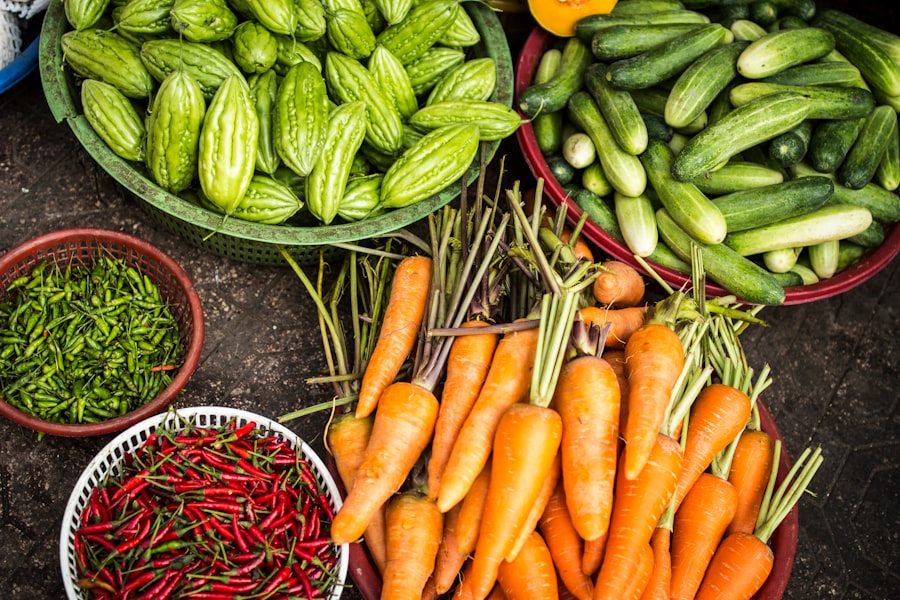
Food security is a fundamental human right and a critical component of global stability and development. It encompasses the availability, access, utilization, and stability of food resources, ensuring that all individuals have sufficient, safe, and nutritious food to maintain a healthy life. The significance of food security extends beyond mere sustenance; it is intricately linked to health outcomes, economic stability, and social cohesion.
When populations experience food insecurity, they are more susceptible to malnutrition, which can lead to a host of health issues, including stunted growth in children and increased vulnerability to diseases. This not only affects individual well-being but also places a burden on healthcare systems and economic productivity. Moreover, food security plays a pivotal role in fostering peace and stability within societies.
In regions where food scarcity prevails, tensions can escalate, leading to conflict and social unrest. Historical examples abound, such as the Arab Spring, where rising food prices contributed to widespread protests and political upheaval. Ensuring food security is thus not merely an agricultural or economic issue; it is a matter of national and global security.
By addressing food insecurity, nations can mitigate the risk of conflict, promote social equity, and enhance overall resilience against crises.
Key Takeaways
- Food security is crucial for ensuring that all individuals have access to safe, nutritious, and sufficient food to maintain a healthy and active life.
- Factors affecting food security include poverty, climate change, conflict, and lack of access to resources such as land and water.
- Strategies for ensuring food security include promoting sustainable agriculture, improving access to education and healthcare, and implementing social safety nets.
- The government plays a crucial role in promoting food security through policies and programs that support small-scale farmers, improve infrastructure, and address food distribution challenges.
- Addressing global food insecurity requires international cooperation, investment in agricultural development, and support for small-scale farmers in developing countries.
Factors Affecting Food Security
Numerous factors influence food security, ranging from environmental conditions to socio-economic dynamics. One of the primary determinants is agricultural productivity, which is affected by factors such as soil health, water availability, and climate conditions. For instance, regions that rely heavily on rain-fed agriculture are particularly vulnerable to fluctuations in weather patterns.
Droughts can decimate crop yields, leading to food shortages and increased prices. Conversely, excessive rainfall can result in flooding, which can destroy crops and disrupt supply chains. The interplay between these environmental factors creates a complex landscape that can either bolster or undermine food security.
In addition to environmental influences, socio-economic factors play a crucial role in determining access to food. Poverty remains one of the most significant barriers to food security. Individuals and families living in poverty often lack the financial resources to purchase sufficient food or invest in agricultural production.
Furthermore, socio-political factors such as governance, conflict, and market access can exacerbate food insecurity. For example, in conflict-affected regions like Yemen or Syria, ongoing violence disrupts agricultural activities and displaces populations, leading to acute food shortages. Addressing these multifaceted factors requires a comprehensive understanding of local contexts and the implementation of targeted interventions.
Strategies for Ensuring Food Security

To effectively tackle food insecurity, a multifaceted approach is essential. One key strategy involves enhancing agricultural productivity through the adoption of innovative farming techniques and technologies. Precision agriculture, for instance, utilizes data analytics and satellite imagery to optimize crop yields while minimizing resource use.
By employing such methods, farmers can increase their output sustainably, thereby contributing to greater food availability. Additionally, investing in research and development can lead to the creation of resilient crop varieties that can withstand climate-related stresses. Another critical strategy is improving access to food through social safety nets and support programs.
Governments and organizations can implement initiatives such as food assistance programs, cash transfers, or school feeding schemes that provide vulnerable populations with the means to secure adequate nutrition. These programs not only alleviate immediate hunger but also promote long-term health and educational outcomes. Furthermore, strengthening local food systems by supporting smallholder farmers and local markets can enhance community resilience and reduce dependency on global supply chains.
The Role of Government in Promoting Food Security
| Metrics | Data |
|---|---|
| Percentage of population with food security | 85% |
| Government spending on food security programs | 10 million |
| Number of food banks supported by government | 150 |
| Percentage of agricultural land under government control | 30% |
Governments play a pivotal role in shaping policies that promote food security at both national and local levels. Effective governance involves creating an enabling environment for agricultural development through investment in infrastructure, research, and education. For instance, building rural roads can facilitate access to markets for farmers, allowing them to sell their produce more effectively and obtain fair prices.
Additionally, governments can support agricultural extension services that provide farmers with essential knowledge about best practices in crop management and sustainable farming techniques. Moreover, regulatory frameworks are crucial for ensuring food safety and quality standards. Governments must establish policies that protect consumers from unsafe food products while also supporting local producers.
This includes implementing measures for monitoring food supply chains and enforcing regulations that prevent contamination or fraud. Furthermore, international cooperation is vital in addressing transboundary issues related to food security. Collaborative efforts among nations can lead to shared knowledge, resources, and strategies that enhance global food systems.
Addressing Global Food Insecurity
Global food insecurity is a pressing challenge that requires coordinated action from multiple stakeholders, including governments, non-governmental organizations (NGOs), and the private sector. One approach to addressing this issue is through international aid and development assistance aimed at improving agricultural practices in low-income countries. Programs that focus on capacity building for local farmers can empower communities to increase their production capabilities while fostering self-sufficiency.
Additionally, global initiatives such as the United Nations’ Sustainable Development Goals (SDGs) emphasize the importance of eradicating hunger by 2030. These goals encourage countries to adopt integrated approaches that address the root causes of food insecurity while promoting sustainable practices. For example, initiatives that combine agricultural development with education on nutrition can lead to improved dietary choices among populations facing hunger.
By aligning efforts across various sectors—healthcare, education, and agriculture—global actors can create a more holistic response to food insecurity.
Sustainable Agriculture and Food Security

Sustainable agriculture is integral to achieving long-term food security while preserving environmental resources for future generations. This approach emphasizes practices that maintain soil health, conserve water, and promote biodiversity. Techniques such as crop rotation, agroforestry, and organic farming not only enhance productivity but also mitigate the negative impacts of conventional farming methods on ecosystems.
Furthermore, sustainable agriculture encourages local food production systems that reduce reliance on imported goods. By fostering local markets and supporting smallholder farmers, communities can enhance their resilience against global market fluctuations. For instance, community-supported agriculture (CSA) programs allow consumers to directly support local farms by purchasing shares of seasonal produce.
This not only strengthens local economies but also promotes awareness about the importance of sustainable practices in ensuring food security.
The Impact of Climate Change on Food Security
Climate change poses one of the most significant threats to global food security in the 21st century. Rising temperatures, altered precipitation patterns, and increased frequency of extreme weather events disrupt agricultural production systems worldwide. For example, regions that traditionally rely on predictable rainfall patterns are now experiencing prolonged droughts or unexpected floods, leading to crop failures and reduced yields.
The impact of climate change extends beyond immediate agricultural challenges; it also exacerbates existing vulnerabilities among marginalized populations. Smallholder farmers in developing countries often lack the resources to adapt their practices in response to changing climatic conditions. As a result, they face heightened risks of food insecurity as their livelihoods become increasingly precarious.
Addressing these challenges requires not only adaptive agricultural practices but also comprehensive policies that support vulnerable communities in building resilience against climate-related shocks.
The Importance of Community Engagement in Food Security
Community engagement is essential for fostering sustainable solutions to food security challenges at the local level. Involving community members in decision-making processes ensures that interventions are tailored to meet their specific needs and circumstances. Participatory approaches allow communities to identify their own priorities regarding food production and distribution while fostering a sense of ownership over local initiatives.
Moreover, community engagement can enhance awareness about nutrition and sustainable practices among residents. Educational programs that involve local schools or community centers can empower individuals with knowledge about healthy eating habits and environmentally friendly agricultural techniques. By cultivating a culture of collaboration and shared responsibility for food security within communities, stakeholders can create lasting change that benefits both current and future generations.
In conclusion, addressing food security requires a comprehensive understanding of its importance and the myriad factors influencing it. Through strategic interventions at various levels—governmental policies, community engagement initiatives, sustainable agricultural practices—stakeholders can work collaboratively towards ensuring that all individuals have access to sufficient and nutritious food. The challenges posed by climate change further underscore the urgency of these efforts as we strive for a more equitable and resilient global food system.
FAQs
What is food security?
Food security refers to the availability, access, and utilization of safe and nutritious food for all individuals at all times. It encompasses the ability of individuals and communities to have reliable access to sufficient, affordable, and culturally appropriate food.
What are the key components of food security?
The key components of food security include food availability, access to food, utilization of food, and stability of these three components over time. Food availability refers to the sufficient supply of food at the national or global level. Access to food refers to the ability of individuals to obtain food, either through purchase, production, or assistance. Utilization of food refers to the proper use of food, including adequate nutrition and safe food handling. Stability refers to the ability of the food supply and access to food to remain consistent over time.
What are the main factors that contribute to food insecurity?
Food insecurity can be caused by a variety of factors, including poverty, conflict, natural disasters, climate change, and inadequate infrastructure. Poverty is one of the leading causes of food insecurity, as it limits individuals’ ability to access and afford nutritious food. Conflict and natural disasters can disrupt food production and distribution, leading to food shortages. Climate change can also impact food security by affecting agricultural productivity and food availability. Inadequate infrastructure, such as lack of transportation and storage facilities, can also contribute to food insecurity.
How does food insecurity impact individuals and communities?
Food insecurity can have significant impacts on individuals and communities, including malnutrition, poor health outcomes, and economic instability. Malnutrition, which can result from inadequate access to nutritious food, can lead to stunted growth, micronutrient deficiencies, and other health problems. Food insecurity can also contribute to economic instability, as individuals and communities may struggle to meet their basic food needs, leading to decreased productivity and increased healthcare costs.
What are some strategies to improve food security?
There are several strategies to improve food security, including increasing agricultural productivity, improving access to markets, promoting sustainable food production, and implementing social safety nets. Increasing agricultural productivity through improved farming techniques and technologies can help to boost food availability. Improving access to markets and transportation infrastructure can help to ensure that food reaches those in need. Promoting sustainable food production practices, such as agroecology and conservation agriculture, can help to protect the environment and ensure long-term food security. Implementing social safety nets, such as food assistance programs and income support, can help to ensure that individuals and communities have access to nutritious food during times of need.






